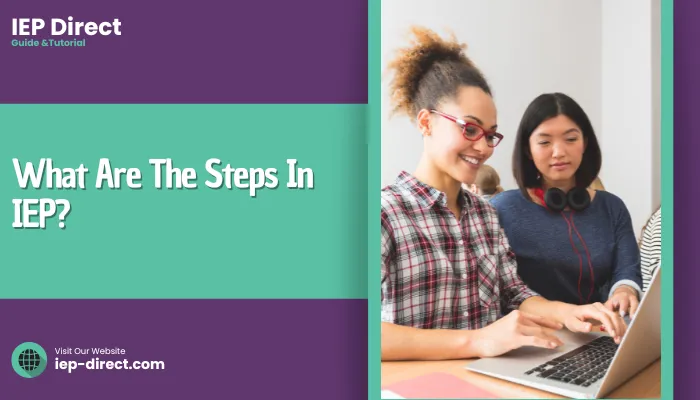What are the steps in IEP Direct? is a question that every parent or guardian of a child with special needs must be able to answer.
An IEP, or Individualized Education Program, is a legally binding document that lays out what education a handicapped person requires. It acts as their educational roadmap, listing all services and supports needed for success in school.
In this guide, we will know what are the steps in IEP. Also, everything is explained properly in deep.

What Are The Steps In IEP? Initial Evaluation
So, What Are The Steps In IEP? Where do we start? Well, let me tell you about an initial evaluation being step one in any IEP process.
Initial Evaluation
An initial evaluation looks at your child’s strengths as well as weaknesses to determine their needs; it’s like taking pictures of where they are now. This helps identify whether or not someone qualifies for special education services.
Importance Of Initial Evaluation
The importance of understanding this cannot be overstated – it forms the foundation for everything else in your child’s journey with an IEP.
Here are some reasons why:
- Identification of Needs: It helps figure out what exactly your child has trouble learning.
- Eligibility Determination: Decides if kids get extra help at school under Federal Law IDEA Part B 2004 Section 602(3).
- Baseline Data: Establishes where someone starts so that progress later on can be measured against something real.
Understanding these foundations is crucial, as they set the stage for your child’s success throughout their educational journey.
Requesting On Evaluation
Requesting evaluations might seem intimidating at first, but don’t worry here are some steps on how to do so:
- Talk To Your Child’s Teacher: Discuss your concerns regarding their academic performance with their teacher because they may have noticed things too.
- Contact School Counselor: They are there to help you through this process, so make use of them.
- Formal Request: If you feel that more needs to be done after talking with the teacher(s) and counselor(s), write a letter requesting an evaluation from the school district special education department. You can also find templates online, which might come in handy.
Remember: It is within your right as a parent or guardian to request one, never hesitate when it comes to advocating for what’s best for your child.
Therefore, Taking these steps ensures your child’s needs are met, empowering you to advocate effectively for their educational success.
Eligibility Determination
After completing initial evaluations, the next step involved in an IEP process is determining whether or not someone qualifies under special education laws.
This part could get quite nerve-wracking, but knowing what are the steps in IEP should help ease any anxiety that arises along the way.
Criteria For Eligibility Determination
In order for a person to be considered eligible for special education services, they must meet certain requirements.
Different states have slightly different versions of these conditions under IDEA’04 (2004) federal legislation, but generally speaking,
Individuals should:
- Have one or more disabilities recognized by law according to IDEA’04 (2004).
- Have a disability adversely affecting educational performance.
- Need specially designed instruction together with related services as well to benefit from schooling.
It is important to note that just having any form of handicap does not automatically entitle one to receive specialized educational services.
What matters most is understanding how such weaknesses affect learning within regular classroom settings.
Determining Eligibility
A team of professionals makes the decision on whether your child is qualified for special education services.
This includes:
- Special Education Teachers: These educators are trained in identifying and assessing students with disabilities.
- School Psychologists: They conduct psychological evaluations to measure cognitive abilities, social-emotional functioning, and behavior.
- Speech-Language Pathologists: They assess speech, language, and communication skills.
- Occupational Therapists: Fine motor skills, sensory processing, and daily living skills are evaluated here.
- Physical Therapists: Gross motor skills, mobility, and physical function are assessed by these specialists.
- Other Specialists: Depending on the needs of your child, there may be other specialists involved, such as vision or hearing specialists.
These evaluation results will be reviewed by this team of professionals, who then determine if your child meets eligibility criteria.
Roadmap For Your Child’s Education
Once you have been told that your child does qualify for special education services, then it is time to start developing an Individualized Education Program (IEP).
Understanding The IEP
An IEP stands for Individualized Education Program. It is a legal document that outlines what a student’s educational needs are and how they will be met through services provided within their school system or district.
In next part we will see different key components of IEP.
Key Components Of An IEP
A well-crafted IEP includes essential components to tailor education to each child’s needs. This ensures that goals, services, and supports are clearly defined for effective learning and progress.
- Present Levels of Performance (PLOP): This section describes where children presently perform academically or socially, what their strengths/weaknesses might be, so teachers know what needs work most urgently!
- Annual Goals: What do we want kids to accomplish during this year?
- Special Education & Related Services: List specific supports like counseling or speech therapy needed by each student.
- Accommodations/Modifications: How can teachers change things up so kids succeed better at learning new stuff?
- Participation with Non-disabled Peers: How will students be included with regular education kids?
- Progress Monitoring: How do we know if our efforts are working?
These key components of an IEP are crucial for creating a tailored educational plan, ensuring that your child receives the necessary supports and achieves their goals effectively.
The IEP Team
A team approach is taken when developing an IEP. This means that many people will need to work together.
Including:
- You, the Parent: You know your child best and can provide input into what works well for them at home or in other environments where school staff may not see everything.
- Your Child’s Teacher: They have experience working with children similar to yours, so they understand some strategies already, which could help meet needs identified through the evaluation process.
- Special Education Teacher: Someone who specializes in teaching students with disabilities like those identified during assessments completed on this child.
- Related Service Providers such as speech therapists or occupational therapists.
A collaborative team approach in developing an IEP ensures that all perspectives are considered, creating a comprehensive plan tailored to your child’s unique needs and strengths.
Determining Services
The team is responsible for determining the special education and related services that your child needs. This step ensures that your child receives tailored support to meet their unique requirements.
The team’s decisions on the appropriate services are crucial for addressing your child’s individual needs, setting the stage for effective support and progress in their educational journey.
Making Adaptations
Making adaptations involves modifying the learning environment to better support your child’s success. This process ensures that the educational setting is optimized to meet your child’s specific needs.
By making thoughtful adaptations, the team ensures that your child’s learning environment is conducive to their development, helping them achieve their goals and thrive academically.
Placement Decision
The placement decision determines the most suitable educational setting for your child. This choice is critical to providing an environment where your child can excel and receive the necessary support.
The right placement is essential for your child’s success, ensuring they are in an environment that supports their growth and allows them to make the most of their educational opportunities.
Preparing For An IEP Meeting
Effective preparation is essential for a successful IEP meeting. Being well-prepared helps ensure that the meeting addresses all important aspects of your child’s education and sets the stage for a productive discussion.
Here are some tips:
- Assessing Your Child’s Progress: Take time to consider where your child is strong, weak, and where they need support.
- Collect Information: Gather any relevant documents such as recent evaluation reports.
- Set Goals: Think about what you want your child to achieve over this next year.
- Ask Questions: Have a list ready of questions that you want to ask the IEP team.
- Bring Support: Consider bringing along a trusted friend or family member who can offer support.
Remember: You are an equal partner in this process. Don’t hesitate to voice concerns or stand up for what you believe your child needs.
Therefore, you can significantly enhance the effectiveness of your IEP meeting and contribute to a plan that truly benefits your child.
Putting The Plan Into Action
Now that you have a solid IEP in place, it’s time for implementation, this is where real progress happens. It is vital that your child’s IEP be implemented as planned.
Here are some steps to take:
- Share the IEP with All Involved: Make sure everyone knows what their goals are and who does what!
- Communication Plan: Set up how often teachers should communicate or when meetings occur between different service providers.
- Regular Meetings: Schedule regular meetings so that adjustments can happen if necessary, as well as being informed about progress made thus far.
- Visualize It: Create a visual representation of their program which they can understand better because of simple language.
The Importance Of Monitoring Progress
Monitoring your child’s progress is key to ensuring that their IEP is effective.
Here’s why:
- Identify Strengths and Weaknesses: Monitoring will help you identify where your child is doing well and where they need more help.
- Make Adjustments When Necessary: If they aren’t meeting goals, work together with others involved in creating new activities within the plan.
- Recognize Achievements: Keep track of how far they have come to motivate further success.
Remember: Nobody knows your child better than you do! Stay involved and stay close.
This approach helps to continuously support their growth and celebrate their progress, fostering ongoing motivation and success.
Conclusion
So we’ve covered a lot about what are the steps in IEP but let’s summarize key points again:
- Initial Evaluation: This is when strengths, weaknesses, and needs are assessed for the student.
- Eligibility Determination: Deciding whether someone qualifies under this category, which would require special education services.
- Developing the IEP: Designing individualized educational plans (IEP).
- IEP Meeting: Gathering all members involved in order to discuss objectives set forth by these programs.
- Implementation: Putting into action such intentions, thus leading one to receive a specific support system outlined through this document.
Be knowledgeable, be engaged, and above all else, have faith in your child’s capabilities.
